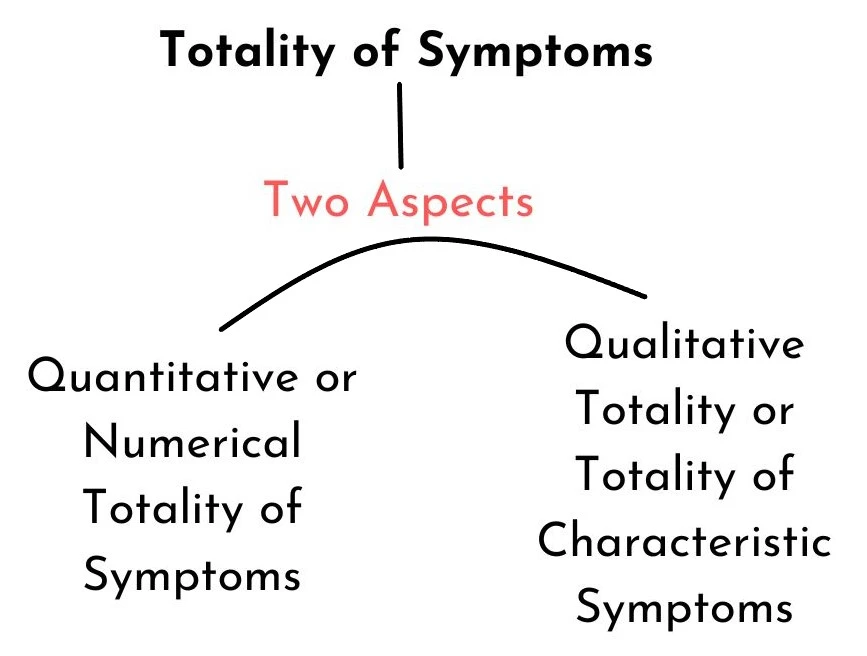
Concept of totality of symptoms is one of the most important concepts in homeopathy. Here is the detailed explanation step by step.
Table of Contents
ToggleWhat Do You Mean by Totality of Symptoms?
When someone falls ill, their body undergoes a series of changes that manifest as various sensations and alterations in bodily functions.
These changes act as valuable clues for medical professionals, aiding them in diagnosing the underlying issue.
These hints, often referred to as “signs and symptoms”, collectively form what is known as the “Totality of Symptoms.”
This concept can be likened to assembling a puzzle that deciphers all the intricate changes transpiring within the body.
The Concept of Totality in Homeopathy
In the world of homeopathy, the “totality of symptoms” is a key approach used to understand someone’s illness.
Imagine having a cold; you might have a runny nose, a cough, and a sore throat.
All these things combined are the “Totality of Symptoms” of your cold.
Different Perspectives on Totality
Various eminent doctors within the field of homeopathy have distinct viewpoints on the Totality of Symptoms:
- P.P. Wells: According to Dr. Wells, it’s not just about quantifying all symptoms, but also delving into the uniqueness of each symptom.
- Von Boenninghausen: Dr. Boenninghausen likens the Totality of Symptoms to a single comprehensive symptom that reflects the individual’s emotional and physical state.
- Richard Hughes: Dr. Hughes compared the Totality of Symptoms to a map that helps doctors understand the disease.
Importance of Totality of Symptoms
When a physician interacts with a patient, they gather a plethora of information regarding the patient’s sensations.
However, not all symptoms are created equal. Some are more distinctive and significant than others.
The crux lies in identifying these distinctive symptoms, which aid doctors in devising the most effective treatment plan.
By combining these unique symptoms, doctors formulate a comprehensive image of the patient’s distress.
It’s like painting a complete picture of your illness by putting together all its different parts.
READ IN DETAIL SYMPTOMATOLOGY IN HOMOEOPATHY BY FOLLOWING THE LINK.
The Two Aspects of Totality of Symptoms

- Quantitative or Numerical Totality of Symptoms: Think of this like having a bunch of marbles of different colours. Some marbles are more important than others, just like some symptoms are more significant.
- Qualitative Totality or Totality of Characteristic Symptoms: This means choosing the most unique and special marbles from that bunch. These marbles are like the really important symptoms that help find the right treatment.
Quantity vs. Quality: A Metaphorical Perspective
Imagine taking a photo of yourself. That photo shows everything about you.
But if someone draws a cartoon or a painting of you, they only capture the most important things that make you, you.
This is like the difference between “numerical totality” (all the symptoms) and “qualitative totality” (the most important symptoms that show who you are when you’re sick).
How Is the Totality of Symptoms Collected?
- Directly from the Patient: The patient is the primary source of symptom information. They express their feelings, indicating areas of pain, factors that exacerbate or alleviate discomfort, and other relevant aspects.
- Input from Family and Friends: Sometimes, patients might overlook certain symptoms. Hence, doctors also consult family and friends to gain insight into any unusual behaviours or health changes.
- Physical Examinations: Observing the patient’s physical appearance, movements, and overall health during visits offers valuable clues. Simple actions like walking, sitting, or reactions can provide vital information.
- Laboratory Tests: Modern medicine employs lab tests such as blood investigations and X-rays to enhance disease understanding. These results contribute to the holistic “Totality of Symptoms.”
Practical Utilization of Totality of Symptoms
- Diagnosis: Doctors use the “Totality of Symptoms” to figure out what’s wrong with the patient and give it a name (like a diagnosis).
- Medicine Selection: Based on the unique and special symptoms, homeopathic doctors choose the medicine that matches the patient’s illness the best.
- Miasmatic Diagnosis: This helps uncover the deeper underlying causes of the disease.
- Potency Selection: It guides doctors in deciding how strong the remedy should be.
- Prognosis: It helps doctors predict if the person can get better and how well the treatment is working.
- General Management: It helps doctors give advice on lifestyle and diet that can aid in recovery.
Illustrative Example
Consider a friend who complains of fatigue (one symptom) and a left-sided headache (another symptom).
These two symptoms collectively form the “Totality of Symptoms” for your friend.
In a homeopathic context, the appropriate remedy (single simple minimal dose) would target fatigue and left-sided headaches both.
The Deeper Dive into 'Totality of Symptoms'
The “totality of symptoms” idea is really important in homeopathy.
It’s about treating the whole person, not just the sick parts.
It means looking at all the signs and symptoms the person has, from when they were healthy to know that they’re sick, before choosing a remedy.
Defining the Logical Totality of Symptoms
The logical totality of symptoms is more than just adding up individual symptoms.
It’s about putting together symptoms in a careful way that makes sense.
It’s like making a clear picture of the person’s illness that’s unique to them.
Components of a Complete Symptom
A complete symptom has three parts:
- Location: This means where the symptom is happening in the body or mind.
- Sensation: Sensation is how the person feels because of the symptom. It can be a physical feeling or an emotion.
- Modality: Modality is about the conditions that make the symptom better or worse. Things like time of day or specific situations matter.
Creating the Totality of Symptoms
Making the totality of symptoms involves looking at all the patient’s information. The doctor has to find special, unique, and odd symptoms and put them together in a smart order. This way, they get a complete picture of the patient’s condition.
Concept of Totality according to Boenninghausen
Boenninghausen came up with the idea of the “Totality of Symptoms” by comparing things and watching how treatments worked. He noticed that many details about a case were connected in a general way.
Boenninghausen said, “The totality of symptoms is like one big symptom that shows how the person is feeling.” So, it’s not just a random mix of symptoms, but a meaningful picture of the patient. This picture should express something important about the patient.
To figure out the important symptoms, we can think about these 7 things:
- Who (Quis): The person’s personality and uniqueness (Individuaity).
- What (Quid): What’s going on with the disease, its special nature.
- Where (Ubi): Where is the disease located in the body.
- With What (Quibus auxilis): Any other symptoms that come along.
- Why (Cur): What’s causing the disease.
- How (Quomodo): How the symptoms get better or worse.
- When (Quando): When the symptoms happen.
Boenninghausen’s idea of the “Totality of Symptoms” was approved by Dr. Hahnemann and other homeopaths.
The Role of Totality in Diagnosis and Treatment
- Building a Full Picture: Making the totality of symptoms is important to understand the person as a whole.
- Finding the Right Remedy: It helps in choosing the best remedy by matching the person’s symptoms.
- Understanding Medicine Better: A clear view of the totality helps in understanding how medicines work.
- Repertorisation: The totality of symptoms aids in selecting appropriate remedies by aligning the patient’s symptoms with those in the repertory.
Conclusion
The “totality of symptoms” in homeopathy goes beyond just physical signs. It’s about seeing the person’s full experience, including their feelings and emotions. By considering everything, homeopathic practitioners can make a detailed portrait of the person’s illness, and this guides them in giving treatments that fit each person’s unique suffering.
